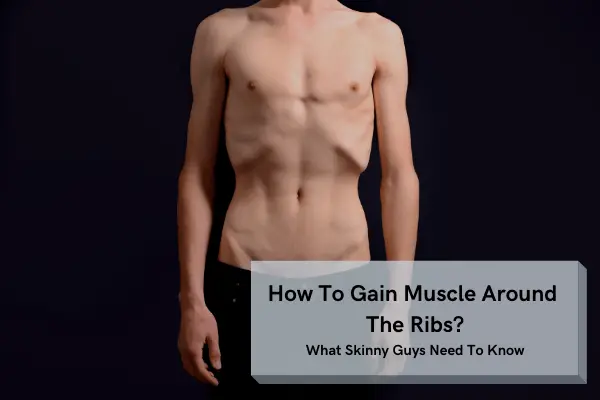Are you fed up with your skinny ribs sticking out like a set of granny fingers? Then stick around! Because today I will be teaching you how to gain muscle around the ribs.
Resistance training combined with a caloric surplus diet and a high protein intake is required to gain muscle around the ribs. Good exercises include horizontal pressing, fly, and pull-down movements to target the serratus anterior, pectoral, and latissimus dorsi muscles.
I use to be a skinny guy myself.
My scrawny ribs made me self-conscious. And I sure as hell wasn’t going to take my shirt off in public! But through research and (a lot) of trial and error, I managed to pack some muscle onto my skinny frame.
So I know you can too!
Are you ready to follow in my footsteps?
Let’s go!

(Left)- One of the rare occasions I actually did take my shirt off in public!
- What Are The Muscles Around The Ribs?
- Resistance Training Exercises To Gain Muscle Around The Ribs
- 1. Pull Ups For Bigger Lats
- 2. Lat Pull Downs Are Also Effective For The Lats
- 3. Push Up Plus To Hit The Serratus Anterior
- 4. Bench Press To Train The Pecs
- 5. Chest Dips For The Lower Pecs
- 6. Chest Flys To Train The Mid Pecs
- 7. Side Bends For The External Obliques
- 8. Rotating Crunch To Train The Obliques
- 9. Oblique Cable Twist For The Abs
- Example Training Programme To Gain Muscle Around The Ribs
- Nutrition To Gain Muscle Around The Ribs
- Conclusion
What Are The Muscles Around The Ribs?
First, let’s identify the muscles that (should) cover the ribs.
Not one single muscle is responsible for covering your rib cage. In fact, 4 distinct muscles are responsible for enveloping the ribs.
The muscles around the ribs are the:
- Serratus anterior.
- Latissimus dorsi.
- Pectoralis minor.
- External obliques.
Combined together, this group of muscles adds muscle mass to the sides of your torso.
Therefore, it is essential to train these component muscles if you want to gain muscle around the ribs!(1)
And when you know how each muscle functions, you will know which exercises to perform (more on that later)!
First, you should know where each muscle is located and what they do.
Serratus Anterior
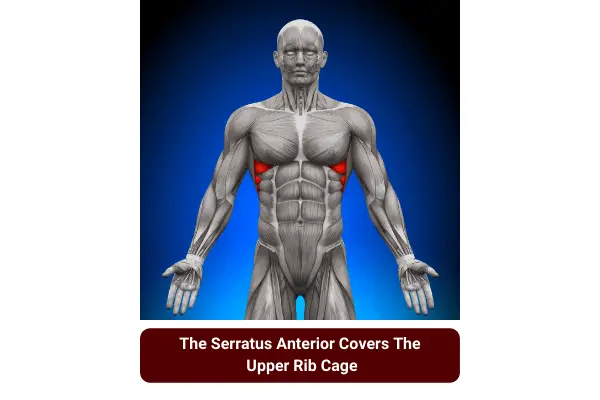
The serratus anterior is also known as the boxer’s muscles.
It attaches to your rib cage (ribs 1 to 9) and scapula (shoulder blade). It functions to pull the scapular forward.(2)
Any movement which arcs your upper arm forward (horizontally around the torso) will engage the serratus anterior.
The serratus anterior is mostly covered by the other 3 muscles below.
But with training, it can become visible. And this will help to cover up those ribs!
Latissimus Dorsi
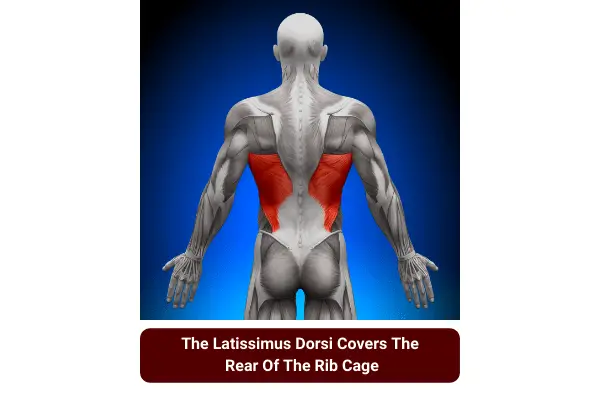
The latissimus dorsi is also known as the wing muscles.
It attaches to the upper arm and the lower back, whilst running across the back of your lower rib cage (ribs 9 to 12).
The latissimus dorsi functions to pull the scapular backward and downwards.(3)
Movements that arc your upper arm downward (vertically along the torso) will engage the latissimus dorsi.
When you thicken the latissimus dorsi, it will cover up the back of your rib cage (making the back of the ribs less visible!)
Pectoralis Minor
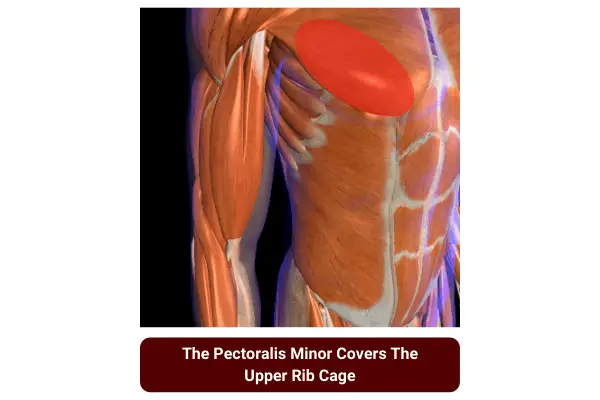
The pectoralis minor is also known as the lower pecs.
It attaches to the upper rib cage (ribs 3 to 5) and the scapular.
The pectoralis minor functions to pull your scapular forward.(4)
Movements that arc your upper arm forward (horizontally around the torso) will engage the pectoralis minor.
The pectoralis minor partly covers the serratus anterior. Therefore, training the pectoralis minor with the serratus anterior will help to cover up the upper rib cage!
You may also be interested in my other article to find out the most common reasons why your pecs aren’t getting bigger!
External Obliques
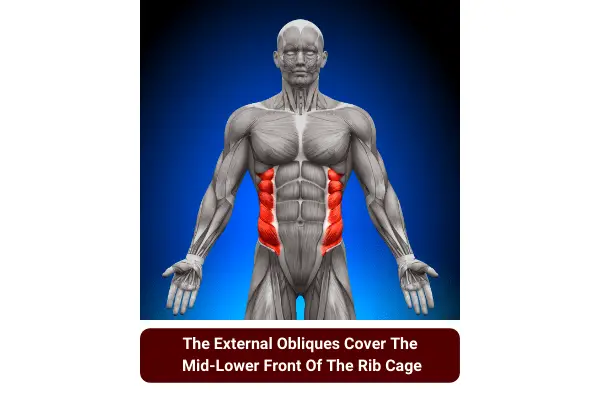
The external obliques are a group of muscles also known as the outer abdominals.
They attach to the lower rib cage (ribs 5 to 12) and the front of the lower torso.
The external obliques function to rotate your torso horizontally.(5)
Therefore, movements that rotate your trunk will engage the external obliques. Additionally, movements that arc your trunk diagonally downwards will also engage the external obliques.
Gaining mass in the external obliques will serve to make the front of your lower ribs less visible!
You may also be interested to read my complete beginner’s guide to gaining your first 10 pounds!
Resistance Training Exercises To Gain Muscle Around The Ribs
Great!
Now you know which muscles cover up your rib cage!
Next, you will learn how to build these muscles (you may also be interested in my other article to learn how to quickly pack on 10lbs in the next 30 days).
In order to do so, you will need to perform resistance training. But don’t worry, I have a list of exercises you can do (see below).
| Serratus Anterior/Pectoralis Major Exercises | Latissimus Dorsi Exercises | External oblique exercises |
|---|---|---|
| Push up plus | Pull up | Side bend |
| Bench press | Lat pulldown | Rotating crunch |
| Dips | Oblique cable twist | |
| Chest flys |
Combined, these exercises will work your serratus anterior, latissimus dorsi, pecs minor, and external obliques.
1. Pull Ups For Bigger Lats
The pull-up is arguably one of the best exercises you can do to develop your lats. All you need is a horizontal bar and your own body weight.
I use and recommend a Power Tower.
Unlike a doorway pull-up bar, a tower won’t damage your property (I’ve had a bar tear down my doorframe in the past!).
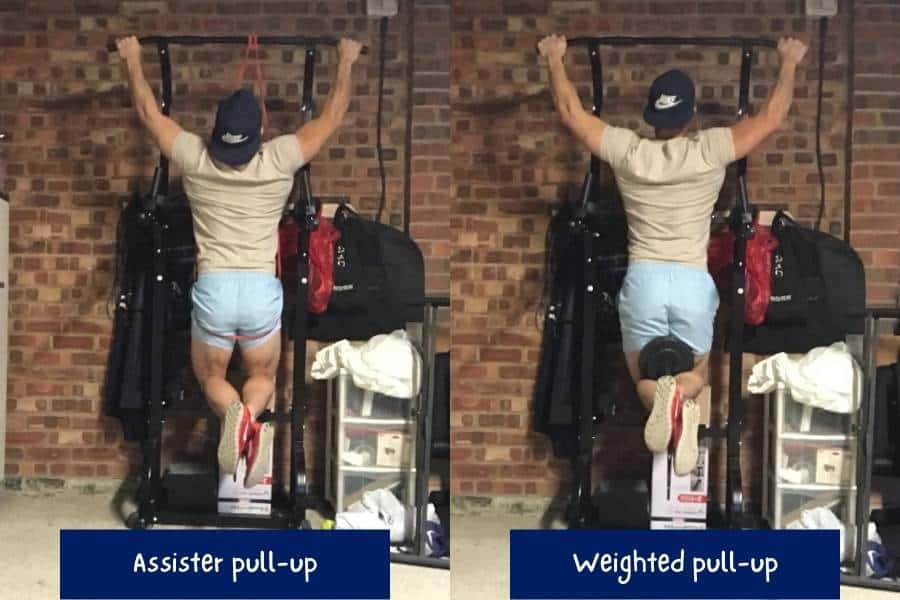
However, the pull-up can be challenging for beginners.
You can try using resistance bands like this Undersun set to help you master assisted pull-ups first.
That being said- master the pull-up and you will be able to add serious muscle mass onto the lower back of the rib cage!
Check out my article to learn how to successfully do a pull-up if you cannot currently do one!
2. Lat Pull Downs Are Also Effective For The Lats
The lat pulldown is another awesome exercise to engage your lats.
The movement is similar to the pull-up. But instead of pulling your own body weight, you are pulling on weights.
This allows you to adjust for a lighter weight.
And this can make the lat pull down more suitable if you are a beginner. That’s because you can start by pulling on a lighter weight!
The lat pulldown is most commonly performed on a pull-down machine. But you can also use resistance bands for a great home workout.
And just like the pull-up, the lat pull-down will develop the muscles in the lower back of your rib cage!
If you’re struggling to put on noticeable mass, you might be interested in my home workout plan for skinny guys to build muscle fast!
3. Push Up Plus To Hit The Serratus Anterior
The pushup plus is an excellent exercise to train your serratus anterior.
Why?
The peak of the pushup plus is very effective at specifically targeting the serratus anterior. And this will help you to gain muscle in the upper ribs.
Additionally, it is a bodyweight exercise. And this means you can perform the push-up plus at home!
If you are a beginner, I would recommend you master the normal push-up first. Once this has been achieved, you can work on the push-up plus.
And for further progression, you can incorporate a resistance band into the movement or try the dumbbell-grip push-up!
Simply wrap a band around your back and position the handles on the ground. Then use your hands and body weight to keep the band securely planted into the ground. Now push into a push-up plus!
If you like, you can also check out my beginner’s guide to gaining your first 10lbs!
4. Bench Press To Train The Pecs
The bench press is a similar movement to the push-up plus.
This exercise will engage the serratus anterior and the pectoralis minor. And developing these muscles will hide those upper ribs.
Unlike the pull-up plus, it is easier to increase the weight on a bench press. Simply add more weight plates!
However, the downside to the bench press is that it requires specific gym equipment (i.e. the barbell and rack!).
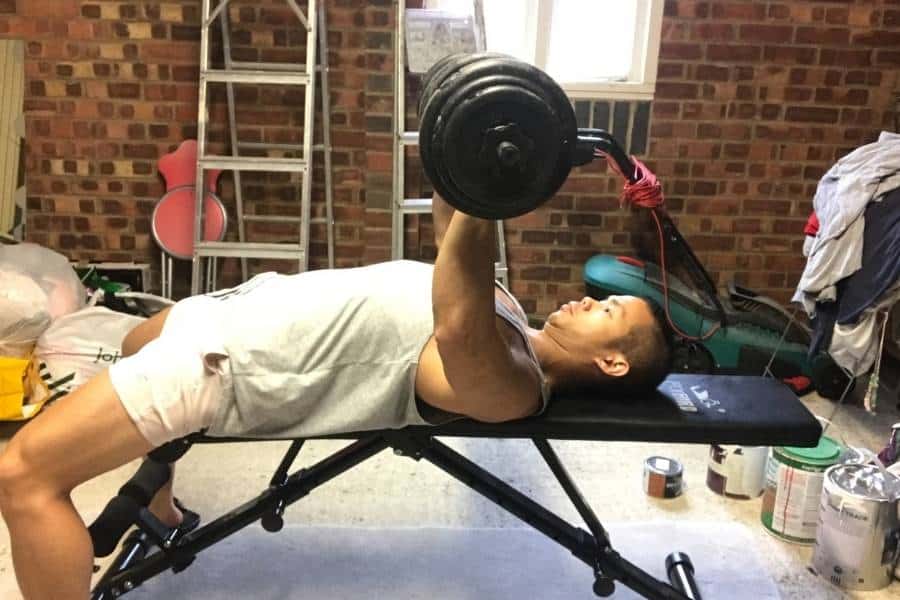
To do this at home, you’ll need a good weight bench like the Flybird. If you’re interested, then you can see my thoughts and opinions on the Flybird here.
You’ll also need weights of course.
I prefer dumbbells over a barbell because they’re cheaper and don’t require much space.
I would stay away from the cheap plastic dumbbells though (what you see in the pic above). Their price tag may look attractive, but I found the plates often crack within 2 years of heavy use (I’ve had to replace 2 sets already).
5. Chest Dips For The Lower Pecs
The dip is another great exercise to add muscle mass to your upper ribs.
The movement of the dip is similar to the bench press. And this makes it great for emphasizing the serratus anterior and pectoralis minor.
The great thing about the dip?
It’s versatility!
It’s primarily a bodyweight exercise. All you need is your body and a dipping station (a chair will do!)
Once your body weight becomes too easy, you can add more weight!
Simply hold a dumbbell between your legs. Alternatively, if you don’t have dumbbells, just find a heavy household object!

If you get a Power Tower (mentioned above) then you can use it to do dips too!
You can check out my other article to find out which chest area the dips focus on.
6. Chest Flys To Train The Mid Pecs
The final chest exercise on this list is the chest fly.
Just like the previous chest exercises, the pec fly will target your serratus anterior and pectoralis minor.
But the exaggerated horizontal arcing movement of the chest fly makes it ideal to target the serratus anterior specifically.
This makes the chest fly an effective way to add muscle to the upper ribs.
However, this exercise requires dumbbells or resistance bands to perform. Thus making it slightly less convenient for homework out.
If you like, you can also check out my other post to find out how to do dumbbell chest flyes on the floor without a bench.
7. Side Bends For The External Obliques
The side bend is a popular exercise to develop your external obliques. And this will allow you to gain muscle in your lower ribs.
This exercise will require either a set of dumbbells or some resistance bands (check out my other article to find out why resistance bands are so effective).
If you can get hold of either equipment, side bends are an awesome beginner-friendly way to work your obliques!
Simply start with low weight and work your way up.
Alternatively- find a heavy household object to replace the dumbbells!
8. Rotating Crunch To Train The Obliques
The rotating crunch is similar to the side bend.
It also works the external obliques to build muscle in your lower ribs.
The crunch is primarily a bodyweight exercise. And this makes it a convenient alternative to the side bend (which requires an external weight).
If you want to ramp things up a gear, you can hold a weight whilst you perform the rotating crunch!
When you do this, you will give your obliques a real workout!
9. Oblique Cable Twist For The Abs
Finally, we have the oblique cable twist.
Just like the side bend and rotating crunch, the oblique twist will also work your external obliques.
But the major difference is that the cable twist involves a horizontal core rotation.
In comparison, the side bend and rotating crunch involve a diagonal core rotation.
And this difference in the rotation will focus the workout on the different areas of the external obliques.
Therefore the cable twist is an excellent complementary exercise to develop the muscles in your lower rib cage!
Example Training Programme To Gain Muscle Around The Ribs
So now you have 9 exercises. But how do you include them in a training plan?
Don’t worry I got you covered!
Whenever you make a weight training plan to gain muscle, you need to consider how many sets to perform every week.
Generally speaking, it is recommended to complete around 10-20 sets per muscle per week. And this is optimal for muscle growth.(6)
As a beginner, I would recommend you stick to the lower end of the spectrum. This is because your muscles are probably not yet adapted to weight lifting yet.
12 sets per muscle per week is good!
If you would like to learn how much weight you should be lifting, check out my guide on choosing the right weight to build muscle!
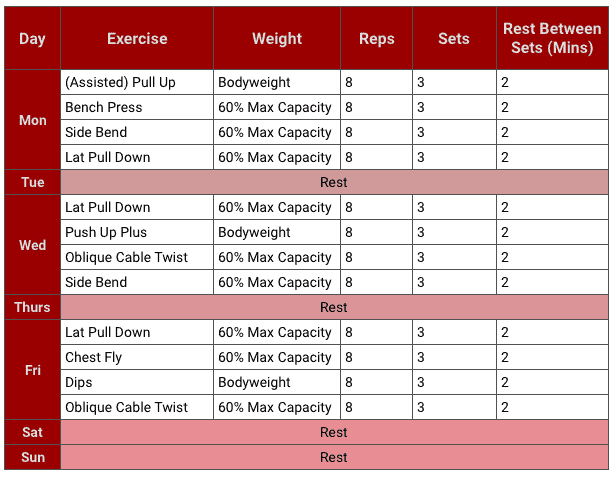
This training plan can be stand-alone.
However, I would highly recommend incorporating other exercises too.
Ideally, you should be working all the muscles across your body. And this will ensure balanced muscle development.
An efficient way to do whole-body weight lifting is to perform compound lifts.
If want to find out more about compound lifts, check out my compound exercise introduction!
Nutrition To Gain Muscle Around The Ribs
Additionally, you will also need to follow a suitable nutrition plan to gain muscle around the ribs.
Now, training is great.
But if you do not combine your workouts with suitable fuel, you simply will not gain muscle.
I will now share a basic nutrition plan to gain muscle.
You may be interested in my other post to find out if skinny guys should go on a bulk or cut.
5-10% Caloric Surplus
Being in a caloric surplus means consuming more calories than your total daily maintenance calories.
When you do this, your body will convert the extra calories into muscle (assuming you are training sufficiently).
And this will fuel the muscle-building process in your serratus anterior, lats, pectoralis minor, and external obliques.
Furthermore, limiting your surplus to 5-10% above maintenance will prevent your body from storing excess fat.
In addition to being in a caloric surplus, you should also follow a macronutrient profile similar to the one below:
| Macronutrient | % Of Total Calories | Approximate Grams Per Day | Reason | Examples |
|---|---|---|---|---|
| Protein | 35% | 1.5g per pound of lean body weight | Protein is required to build muscle. If you under-consume protein, your body will not build muscle. | Lean red meat, poultry, fresh fish and shellfish, legumes, and soy products. |
| Complex Carbohydrates | 35% | 2.5g per pound of body weight | Complex carbs fuel your workouts. Aim to consume most of your carbs during the day (especially pre and post-workouts). | Potatoes, whole grain pasta/bread, legumes. |
| Healthy Fats | 20% | 0.4g per pound of body weight | Healthy fats also fuel your workouts. But they are also required for hormone production and muscle growth. | Oily fish, nuts, seeds, vegetable oils, avocados. |
| Fibre | 10% | 6 portions of fruit and veg | Dietary fiber will slow down your digestion. This allows your body to absorb the maximum amount of nutrients from your meal. | Fresh fruit and veg |
You can go to my other post to find out how much time it takes a skinny guy to bulk.
Conclusion
That’s today’s post finished!
I have taught you how to gain muscle around the ribs.
You will need to undertake a resistance training program that focuses on developing the serratus anterior, latissimus dorsi, pectoralis minor, and external oblique muscles.
In addition to this, you should also follow a nutrition plan which is conducive to muscle building. Furthermore, the ideal nutrition plan should put you in a mild caloric surplus. It should also contain a balanced intake of protein, complex carbs, healthy fats, and dietary fiber.
Having visible ribs is a common source of grief for many skinny people. Indeed, I had the same problem 2 years ago! But I was able to pack on muscle to cover those ribs. And I know you can too!
Have you tried my rib muscle-building workout and nutrition plan? How did it go?
Feel free to send me a message if you have any questions! You can find my details on the “contact us” page.
You may also be interested in the downloadable Kalibre Blueprint PDF which details exactly how I gained 40lbs of lean muscle (it’s 100% free!). It details the exact exercises and nutrition (with printable worksheets) I used to go from skinny to ripped!
Thanks for reading guys!
Peace Out,
Kal
(Biochemistry BSc, Biomedical Sciences MSc, Ex-Skinny Guy)

